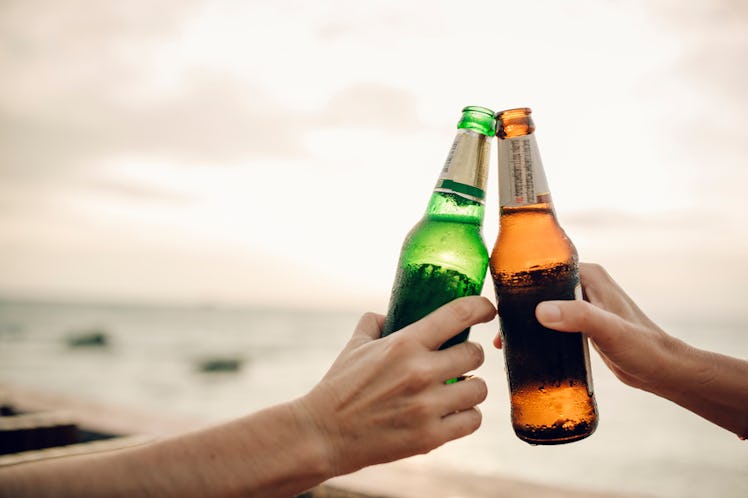
This Is What Really Goes Into All The Green Beer You'll Drink This St. Patrick's Day
St. Patrick's Day is around the corner, and you know what that means: It's time to prepare for loud parades, green outfits, and more beer than you'd ever want to drink on any other day. But it's not just normal beer; it's green beer, which seems pretty unappetizing as a general tradition, but seems to stick around every year. But what exactly is in green beer? As it turns out, it's not quite as simple as putting a few drops of green food dye in any old cup of beer.
Creating the perfect emerald hue for your beer on St. Patrick's Day is all about picking the right type of beer. This is good news, because it proves there aren't actually a ton of creepy ingredients required to turn your beer green — it's just food dye and beer. But it's slightly bad news in that it requires some mild preparation. Since you need the right type of beer to get that green coloring, you're going to have to plan out your shopping in advance.
For the absolute best results, you should opt for a light-colored brew, according to The Spruce.
Beers like Budweiser, Miller Light, and Coors are all perfect light beer options that will immediately turn green with a drop or two of food dye. Even better, they're a lower percentage of alcohol, according to The Atlantic, which is ideal when you're planning to drink more than usual throughout the day. But something like an IPA? Not so much. You'd probably be down for the count after two green IPA beers.
If the shopping mall is totally out of green food dye, don't panic. As it turns out, you can use blue food dye in light beers as well, according to Food & Wine. The blue mixes with the yellowish color to make a perfect green, as long as, again, you're using a super light beer for the recipe.
If your friends are insistent on staying true to Irish tradition and drinking something dark like Guinness all day (which is actually pretty low in alcohol percentage, too, ringing in at about 4.2 percent, according to Health), then you might want to bypass the green or blue food dye and just drink the beer as is. Dark beers and stouts will require you to add a ton of food dye to see a difference in color, and this might change the actual flavor of the beer, which probably isn't what you want.
The ingredients of food coloring are pretty simple, with the main one simply being water.
But if you're not into drinking preservatives, you can opt for an all-natural food dye, which is basically just spinach blended with water. According to Babble, this recipe will definitely not make your beer taste like spinach. With that said, you might want to give it a quick taste before you dump a bunch of all-natural spinach dye into your best friend's keg.
The tradition of drinking beer on St. Patrick's Day is pretty unavoidable, given how deeply entrenched it is in the history of the day itself, both for the United States and Ireland. St. Patrick's Day began as a feast in honor of Saint Patrick, the most significant saint from Ireland. Traditionally, since St. Patrick's Day falls during lent, it's the one day Christians are allowed to drink alcohol before lent is over, which is supposedly why the tradition led to such intense drinking.
If you can't stand beer, there's one other type of alcohol that you could opt for, while still staying within the St. Patrick's Day spirit: You could swap out that cup of beer for a shot of whiskey. Either way, drink responsibly, my friends!